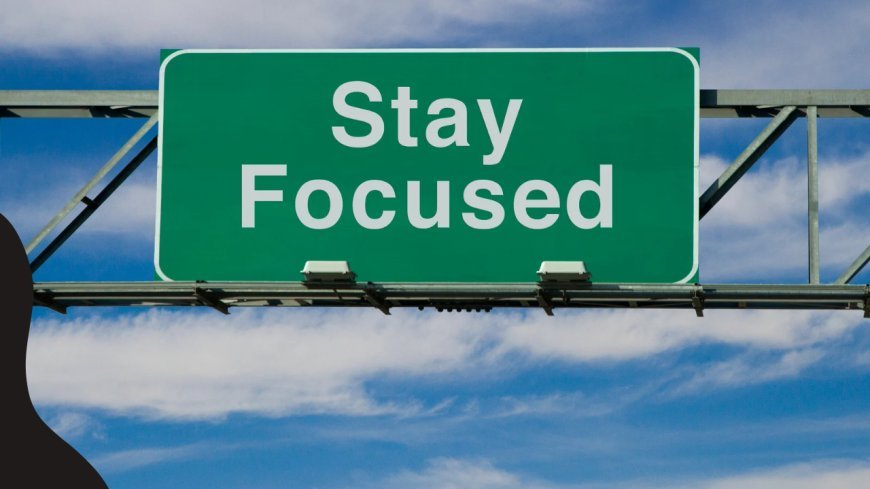How to Stay Focused in a Distracted World: Simple Tips for Better Concentration
In today’s fast-paced world, distractions are everywhere. Whether it's notifications from your phone, noise from your surroundings, or even your own wandering thoughts, staying focused can feel like a constant battle.

In today’s fast-paced world, distractions are everywhere. Whether it's notifications from your phone, noise from your surroundings, or even your own wandering thoughts, staying focused can feel like a constant battle.
To stay focused in a distracted world, you can create a structured routine, set clear goals, and minimize interruptions.
One effective way to improve your focus is by scheduling specific times for tasks. This helps you stay on track and lets others know when you are unavailable.
Another technique is to practice mindfulness, which can train your brain to concentrate better and reduce stress.
By using these strategies, you can cultivate a focused mindset and accomplish what truly matters in your day. Don't let distractions win; take control of your attention and see how much more you can achieve!
Understanding Focus in a Distracted World
In today's fast-paced environment, staying focused can be a challenge. Understanding how concentration works and what distractions impact it most is crucial for improving your ability to focus.
The Science of Concentration
Concentration involves your brain's ability to focus on one task at a time. When you concentrate, your mind filters out distractions, allowing you to engage deeply with your work.
Research shows that our brains function best when focused on a single task.
When you switch tasks too often, it can lead to mental fatigue and lower productivity. This phenomenon is called “task-switching cost.” You may feel busy but accomplish less.
To enhance focus, aim for periods of uninterrupted work. Consider using techniques like the Pomodoro Technique, which involves working for 25 minutes, then taking a 5-minute break.
Common Distractions and Their Impact
Distractions can come from various sources. Common ones include notifications from your phone, background noise, and even multitasking. Each distraction pulls your attention away from your main task, making it harder to maintain concentration.
For example, research indicates that checking your phone while working can significantly reduce your focus. Social media, emails, or even chatty coworkers can disrupt your workflow.
To combat these distractions, try creating a dedicated workspace. Silence notifications, use noise-canceling headphones, or set specific times for checking messages. These steps can help you regain control over your focus and increase your productivity.
Strategies for Enhancing Focus
Staying focused can be tough in today’s fast-paced world. You can improve your ability to concentrate by adopting specific strategies that revolve around deep work, productivity techniques, and effective time management.
Cultivating Deep Work
Deep work is all about engaging in tasks that require your full attention. This concept, introduced by Cal Newport, emphasizes the importance of focusing on challenging tasks without distractions.
To cultivate deep work, start by setting clear goals. Identify what you need to accomplish and break it down into specific tasks.
Create a dedicated workspace. This should be quiet and free from interruptions. Silencing notifications and turning off your phone can help you maintain focus.
Finally, schedule regular blocks of deep work. Aim for sessions of about 90 minutes, allowing breaks in between to recharge.
The Role of Productivity Techniques
Productivity techniques can help you structure your work in a way that enhances focus. Techniques like the Pomodoro Technique allow you to work in short bursts, followed by a short break.
In this method, you work for 25 minutes, then take a 5-minute break. This approach helps to maintain your concentration and prevents burnout.
Another helpful technique is the Eisenhower Matrix. This tool helps prioritize tasks based on urgency and importance. By sorting tasks, you can focus on what really matters and avoid wasting time on less significant activities.
Leveraging Time Management
Good time management is essential for maintaining focus. Start each day by planning your priorities. Make a to-do list that outlines what you need to achieve.
Use tools like calendars or apps to schedule your activities. This gives you a visual sense of your day, helping you stay on track.
Consider batching similar tasks together. For example, answering emails can be scheduled at a specific time instead of randomly throughout the day. This method minimizes distractions and keeps you focused on one type of work at a time.
Navigating the Digital Age
In today’s world, distractions are everywhere, especially with the rise of digital technologies. Understanding how social media and multitasking affect your focus can help you find better ways to stay on track.
Social Media and Its Effects on Focus
Social media can pull your attention away from tasks. Notifications and updates seem to demand your immediate response. You might spend more time scrolling than intended.
This can lead to fragmented attention. When you jump from one post to another, your brain works harder to keep up. You may find it takes longer to complete tasks after being sidetracked.
To help manage this, consider setting specific times for social media. You could use apps that limit your screen time or silence notifications during work hours. Creating boundaries with your digital life can help you regain focus and be more productive.
Multitasking in a Hyper-Connected World
Multitasking feels common in today’s fast-paced environment. You might think doing several things at once is efficient. However, studies show multitasking can actually lower your productivity.
When you switch between tasks, your brain needs time to adjust. This can lead to mistakes and make simple tasks take longer.
Instead of juggling multiple screens, try focusing on one task at a time.
Use tools like timers to create focused work sessions. You might try the Pomodoro technique, where you work for 25 minutes and then take a short break. This can improve your focus and make your work feel more manageable.
Setting Goals for Focused Success
Setting goals is key to achieving focused success. When your goals are clear, achievable, and prioritized, you can better manage your time and energy. This clarity helps you stay on track despite distractions.
Defining Clear and Achievable Goals
To stay focused, you need to define clear and achievable goals. SMART goals are a great framework to follow:
- Specific: Make sure your goals are clear.
- Measurable: You should be able to track your progress.
- Achievable: Set goals that are realistic.
- Relevant: Goals should matter to you.
- Time-bound: Set a deadline to increase motivation.
When you set these types of goals, you have a better chance of success. Write your goals down and review them regularly. This keeps them fresh in your mind.
The Importance of Prioritization
Prioritization helps you determine which tasks matter most. When you prioritize, you decide what will bring you closer to your goals. Start by listing your tasks for the day or week.
Rank them based on urgency and importance. Focus on high-priority tasks first. Here’s a quick way to categorize them:
- High Importance, High Urgency: Do these tasks immediately.
- High Importance, Low Urgency: Schedule these for later.
- Low Importance, High Urgency: Delegate or minimize these tasks.
- Low Importance, Low Urgency: Remove these from your list.
Clear prioritization reduces stress and keeps you focused on what truly matters.
Understanding Urgency Versus Importance
Knowing the difference between urgency and importance can change how you work. Urgent tasks demand immediate attention, while important tasks contribute to your long-term goals.
To manage these effectively:
- Ask if a task is urgent or important.
- Use a matrix to visualize the difference.
When you plan your day, prioritize important tasks over urgent ones.
This makes sure you are not just busy, but productive. Balancing urgency and importance leads to better focused success in your work and life.
Practical Approaches to Overcome Procrastination
Staying focused can feel tough, especially with distractions everywhere. Here are some practical techniques and decision-making steps you can take to overcome procrastination and get things done.
Techniques to Combat Procrastination
One effective way to beat procrastination is to start small. Break your tasks into tiny steps. Instead of saying, “I’ll write a report,” say, “I’ll write one paragraph.” This makes starting less overwhelming.
Another helpful method is to set a timer. Try working for just five minutes. Once you start, you might find it easier to keep going.
Also, consider creating a distraction-free environment. Turn off notifications on your phone and find a quiet spot to work.
Using checklists can also help. Write down what you need to do, and check off tasks as you complete them. This gives you a sense of accomplishment and can motivate you to tackle more.
Decision-Making to Propel Action
When it comes to decision-making, clarity is crucial. Identify your priorities by asking yourself what needs your attention first. Focus on tasks that align with your goals.
You can also apply the 2-Minute Rule. If a task takes less than two minutes, do it right away instead of putting it off. This decision can help clear your plate quickly.
Another useful approach is visualizing the consequences of procrastination versus action. Picture how you will feel once a task is finished. This can motivate you to make the right choice.
Combine these strategies with your own unique style to create a personal action plan that works for you!
Building a Lifestyle Conducive to Eudaimonia
Creating a lifestyle that supports eudaimonia involves understanding its philosophy and applying its principles to your daily life. Eudaimonia means achieving a fulfilling, meaningful life through personal growth and virtue.
The Philosophy Behind Eudaimonia
Eudaimonia is a concept rooted in ancient Greek philosophy, particularly by Aristotle. It emphasizes living well and realizing your potential. This isn't just about happiness but achieving a deeper sense of purpose.
To embrace this, reflect on what truly matters to you. Identify your passions and values. This self-awareness helps you make choices that align with your eudaimonic goals.
Additionally, eudaimonia encourages virtue and ethical behavior. When you act in harmony with your values, your sense of well-being can increase. Engaging in meaningful relationships is also key, as they nurture your spirit and reinforce your sense of belonging.
Incorporating Principles of Eudaimonia into Daily Life
To incorporate eudaimonia into your daily life, focus on balance and reflection. Here are some practical steps:
- Set meaningful goals: Define what personal growth looks like for you.
- Practice mindfulness: Regularly pause to reflect on your thoughts and actions.
- Cultivate relationships: Spend time with those who inspire and support you.
- Engage in activities that matter: Choose hobbies or work that aligns with your passions.
Incorporating these principles enhances your overall quality of life. Fostering positive habits helps you move closer to eudaimonia and create a fulfilling lifestyle.
What's Your Reaction?
 Like
0
Like
0
 Dislike
0
Dislike
0
 Love
0
Love
0
 Funny
0
Funny
0
 Angry
0
Angry
0
 Sad
0
Sad
0
 Wow
0
Wow
0
































